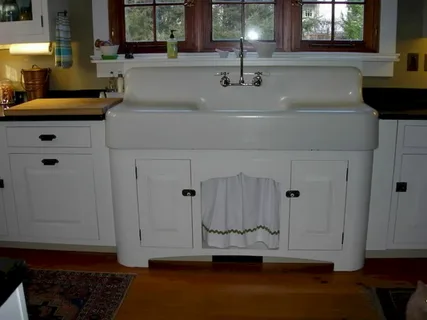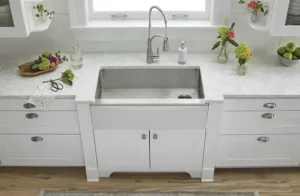Introduction to Farmhouse Sinks
Farmhouse sinks, sometimes called apron-front sinks, are a classic style of sink that originally emerged in the late 19th century farmhouses and country kitchens. With their deep, wide basins and exposed front apron, farmhouse sinks embody a vintage, rustic aesthetic that remains widely popular today.
Unlike most modern sink styles that are installed under the countertop, farmhouse sinks are designed to be dropped into a sink base cabinet so the front apron is visible. This charming, old-fashioned look exposes the sunk’s materials and finishes to complement the kitchen decor. Common materials for farmhouse sinks include stainless steel, enameled cast iron, fireclay, and even natural stone.
Key defining features of farmhouse sinks include:
- Exposed apron front that protrudes from the cabinetry
- Deep, wide single basin design
- Materials like stainless steel, enameled cast iron, fireclay, and stone
- Vintage appeal that suits rustic, country, and farmhouse style kitchens
From sleek stainless steel to colorful enameled cast iron, farmhouse sinks come in a range of styles to match any kitchen aesthetic. Their spacious single bowls and charming vintage vibe make them a fixture in today’s farmhouse chic kitchens.
Benefits of Farmhouse Sinks
Farmhouse sinks offer several benefits that make them a popular choice for many homeowners’ kitchen renovations and remodeling projects. The most notable advantages of farmhouse sinks include:
**Large and Deep Basin Capacity**
One of the defining features of a farmhouse sink is its spacious, deep basin. Farmhouse sinks are designed to be installed into the countertop rather than mounted underneath like a drop-in sink. This allows for a much deeper basin, usually at least 10 inches deep. The extra depth provides more room for washing large pots, pans, and dishes. Farmhouse sinks can handle soaking thick cutlery and oversized cookware with ease.
**Versatile Style Works With Many Kitchen Designs**
While termed a “farmhouse” sink, this style has evolved to work well in many kitchen aesthetics beyond just rustic or country-style decor. The apron-front look complements everything from modern and industrial designs to traditional and transitional kitchens. Farmhouse sinks pair nicely with natural materials like wood and stone countertops. Their vintage appeal works with painted cabinets and subway tile backsplashes.
**Durable Materials Like Enameled Cast Iron, Copper, Stainless Steel**
Farmhouse sinks are crafted from long-lasting, rugged materials designed to stand up well to heavy daily use. Enameled cast iron provides a smooth, glossy finish immune to acids from foods. Solid copper develops a living patina over time. Stainless steel offers superior durability and heat resistance. These and other material options ensure farmhouse sinks can maintain their functionality and visual appeal for years to come.
Popular Materials for Farmhouse Sinks
Farmhouse sinks come in a variety of materials, each with their own aesthetic appeal and functional benefits. Some of the most popular materials for farmhouse sinks are:
Stainless Steel
Stainless steel is one of the most common and affordable sink materials on the market. It offers great durability and stain resistance. Stainless steel is easy to clean and maintain. It resists scratching, denting, bacteria, and rust. Stainless steel provides a modern, versatile look that fits into almost any kitchen design from traditional to contemporary. The smooth, non-porous surface does not absorb odors or flavors either. Stainless steel farmhouse sinks are an economical choice that hold up well against heavy daily use.
Cast Iron
Cast iron offers a classic farmhouse sink look with a smooth, porcelain enamel finish. It’s praised for its heat retention abilities that make it easy to soak pots and pans directly in the sink. The thick material also dampens vibrations and noise when washing dishes. Cast iron is durable but prone to chipping if dropped. Extra care while cleaning is required. The traditional style works well in farmhouse, country, or vintage kitchen settings.
Copper
Copper farmhouse sinks provide natural antibacterial properties. This helps eliminate bacteria and germs during food prep and cleanup. Copper sinks are also praised for their patina finish that forms a unique aged or weathered appearance over time. The natural patina adds rustic character. The warm glow of copper can accentuate other metals in the kitchen like brass fixtures or pendant lights as well. Copper does require more maintenance though. It needs to be cleaned and dried thoroughly after each use. Despite the higher maintenance needs, copper offers a high-end, artistic look.
Key Styles of Farmhouse Sinks
Farmhouse sinks come in a variety of styles to suit different needs. Some of the most popular styles include:
Front Apron Sinks
Front apron sinks feature a large, deep basin and an exposed front apron. The apron is visible and acts as a design element that makes a statement. Front apron sinks have a classic, timeless look and come in single or double bowl options. They give a kitchen vintage charm.
Double Bowl Sinks
Double bowl farmhouse sinks provide two basins side-by-side. This makes it convenient to wash dishes in one basin while rinsing them in the other. It also allows for multi-tasking, like soaking dishes in one basin while washing produce in the other. Double bowl sinks maximize functionality and efficiency.
Workstation Sinks with Accessories
Workstation farmhouse sinks incorporate various accessories like sliding cutting boards, colanders, and dish racks. The accessories integrate into the sink to create an all-in-one food prep station. Workstation sinks add functionality and can save counter space. Popular accessories include wood cutting boards, roll-up dish drying racks, and stainless steel colanders.
The main farmhouse sink styles have distinct forms and features to deliver on visual appeal and utility. Carefully considering how you use your kitchen can help determine the right sink style for your needs. From vintage front aprons to double bowls and integrated workstations, there are many options to match any kitchen’s style and function.
Choosing the Right Size
When selecting a farmhouse sink, it’s important to consider the size and dimensions that will work best for your kitchen’s layout and workflow. The standard farmhouse sink size is 30 inches wide by 21 inches front-to-back. However, farmhouse sinks come in a range of widths from 24 to 48 inches. Here are some tips for choosing the right farmhouse sink size:
- Consider your kitchen’s size and layout. Measure the existing sink base cabinet space to determine the maximum dimensions your new sink can be. Leave at least 2 inches of countertop on each side of the sink. Make sure to account for the faucet and backsplash too.
- Standard farmhouse sink sizes include:
- 24 inches wide x 21 inches deep
- 30 inches wide x 21 inches deep
- 33 inches wide x 22 inches deep
- 36 inches wide x 22 inches deep
- For small kitchens, a 24-inch sink provides an efficient cleaning workspace without dominating the room. 30 inches is a common width for medium kitchens. Larger kitchens can accommodate sinks up to 48 inches wide.
- If your existing sink cutout is an odd size, you’ll need a custom-sized sink. Many manufacturers can customize farmhouse sink dimensions. Provide them with your exact measurements.
- Consider your family’s habits. Do you regularly wash large pots and pans by hand? A deeper sink basin around 10 inches provides ample room. Prefer an easy-to-reach workspace? Choose a shallower 7-8 inch depth.
- Farmhouse sink weight increases with larger sizes. Make sure your cabinetry can support a heavy sink, especially for a stone material. Consult a contractor if unsure.
Choosing the right farmhouse sink size involves carefully measuring your existing space and thinking about how you use your kitchen. This ensures your beautiful new sink not only fits, but also works hard for you each day.
Installation Tips
Installing a farmhouse sink requires careful preparation and precision to ensure proper function and prevent leaks. Professional installation is recommended if you don’t have experience with sink replacements.
Before starting, turn off the water supply lines and disconnect the existing sink. Remove the old sink, faucet, strainers, and any other components.
Inspect the countertop cutout and make any adjustments needed to accommodate the new sink. Follow the manufacturer’s template for the ideal cutout size. The cutout edges should be smooth and even.
Position the new sink centered in the cutout and shim as needed to level it. Secure the sink in place following the manufacturer’s directions, often using clips, brackets, silicone adhesive or epoxy.
Hook up the faucet, drain, and supply lines according to the sink specs. Check for leaks and test water flow. Seal the gap between the sink and countertop using silicone caulk. Tool the caulk smoothly for a seamless finish.
Allow time for caulk and epoxy to fully cure before using the sink. Proper installation techniques create a watertight seal to prevent leaks under heavy use. With careful prep and precision, you can install a stunning farmhouse sink as a focal point of your kitchen.
Caring for a Farmhouse Sink
Farmhouse sinks are designed to be durable, yet need proper care and maintenance to look their best and last for years. Here are some tips for keeping a farmhouse sink in good condition:
- **Clean regularly with mild soap and water** Daily cleaning with a soft sponge or cloth and a mild detergent or dish soap will help remove dirt, grime, and grease that can build up over time. Avoid letting stains set by wiping down the sink after each use.
- **Avoid abrasive cleaners** Chemical cleaners and abrasive pads can scratch or dull the finish of a farmhouse sink. Stick to soft cloths or sponges when cleaning to maintain the original look.
- **Re-seal when needed** The sealant around a farmhouse sink prevents leaks and moisture damage. Check for any cracks in the sealant annually and re-apply fresh sealant if needed to keep water from penetrating behind the sink.
- **Protect and polish finishes** For sinks with patinas like copper or bronze, routinely polishing with specialty waxes or cleaners will maintain the antique finish. For enameled sinks, apply a nonabrasive wax occasionally to protect the surface.
Proper care will help preserve a farmhouse sink’s beauty and function. Daily cleaning along with routine sealing and polishing based on the sink’s material will keep it looking like new for many years. Avoiding harsh scrubbing and harsh chemicals is key to maintaining the attractive look of a farmhouse sink’s finish. With some simple maintenance, a farmhouse sink can stay in top condition and work well in a kitchen.
Cost Considerations
Farmhouse sinks can range in price from around $300 on the low end, up to $1,000 or more for high-end designer models. The main factors that affect the cost are the material, size, and any accessories included with the sink.
- **Materials** Stainless steel farmhouse sinks are generally the most affordable, starting around $300. Enameled cast iron sinks are moderately priced in the $500 to $800 range. More premium materials like natural stone, copper, or fireclay can run $800 to $1,000 or more.
- **Size** Larger, deeper farmhouse sinks will naturally cost more than smaller models. A basic 30″ wide stainless steel single basin may run around $300, while a large 40″ wide double basin can cost $600 to $800.
- **Accessories** Many farmhouse sinks come as part of a package that includes accessories like faucets, cutting boards, bottom grids, strainers, and more. Packages with additional accessories will be priced higher than a standalone sink.
In addition to the sink itself, you may need to account for extra plumbing work and modifications to accommodate a farmhouse sink install. The existing plumbing may need to be moved or extended to center the sink under the window. Or if switching from a single to a double basin sink, new drain lines will need to be added. Any required countertop modifications or additional labor will also add to the total project cost.
Overall the average budget for most farmhouse sink installations ranges from $500 to $1,000, depending on the specifics of your kitchen space and setup. Carefully measure your existing cabinetry, research what sink will fit the space, and plan for any additional installation work needed. This will help provide the most accurate estimate of the total cost.
Top Brands
When shopping for a farmhouse sink, some of the top brands to consider include:
Elkay
Founded in 1920, Elkay is one of the oldest and most recognizable names in kitchen sinks. They offer a wide selection of farmhouse sinks in stainless steel, fireclay, cast iron, and composite materials.
Elkay farmhouse sinks feature stylish designs and come in multiple sizes. Most of their sinks have limited lifetime warranties. While Elkay sinks are more expensive than some other brands, they are known for superior quality and durability.
Kohler
Kohler is another well-known brand that produces many kitchen, bath, and decorative plumbing fixtures. They have an extensive line of farmhouse sinks in enameled cast iron, stainless steel, fireclay, and composites.
Kohler farmhouse sinks come in standard and custom sizes. Their sinks have excellent quality but are some of the pricier options. Kohler offers a limited lifetime warranty on most models. They are a good choice if budget is not a major concern.
Ruvati
Ruvati is a newer player that offers mid-priced farmhouse sinks. Most of their sinks are stainless steel but some composite options are available.
Ruvati farmhouse sinks come with limited lifetime warranties. While not as premium as brands like Kohler, Ruvati sinks offer a good balance of quality and affordability. Their stainless steel sinks are thick and durable.
Ruvati provides styles that mimic higher-end sinks at more budget-friendly price points. They are a great option to consider if you want quality without overspending.
In summary, brands like Elkay, Kohler and Ruvati all produce quality farmhouse sinks with different warranty coverage, price points and material options. Consider factors like budget, material, warranty length and design style when choosing among the top brands.
Conclusion
Farmhouse sinks can make a beautiful and functional addition to many kitchens. With their deep basins, exposed front, and vintage styling, they bring both aesthetic appeal and utility.
When choosing a farmhouse sink, consider the material, size, style, and installation type that best fits your needs. Materials like fireclay, cast iron, stainless steel, and composites all have their own pros and cons for durability, maintenance, and cost. The single bowl or double bowl layout, apron front shape, and accessories can all customize the look and functionality of your sink. Precise measurements of your space and cabinetry are needed to select the right dimensions. Undermount, self-rimming, and apron-front mounting provide different installation options as well.
Proper care through regular cleaning and sealant application helps preserve a farmhouse sink for years of beauty and reliable performance. While more expensive than a traditional sink, a farmhouse model makes a sophisticated focal point that can significantly enhance your kitchen. Take the time to research different brands, materials, and options to find the perfect farmhouse sink for your home. With some thoughtful planning during selection and installation, a farmhouse sink can provide charm and convenience to savor for years to come.



